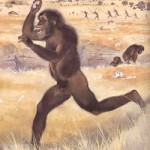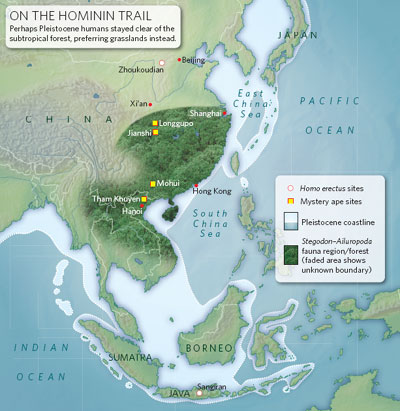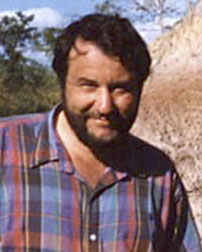
June 21, 2009
A fossil discovery of several years ago that was found along with the remains of elephant-like Stegodon, a prehistoric panda Ailuropoda, and the extinct giant ape Gigantopithecus, as well as the ancestors of the living orangutan (Pongo) and gibbon (Hylobates), has been reevaluated as a new “mystery ape.” Actually, the author of the new announcements say there may be “one or more mystery apes indigenous to southeast Asia’s Pleistocene primal forest.”

Click on the map for more details about this fossil ape’s range.
Brian Handwerk reports at National Geographic News on this intriguing idea from Gigantopithecus authority Russell Ciochon, which was announced in the July 18, 2009, issue of the journal Nature.
The link to the Nature item is here. Handwerk’s summary is below.
…the anthropologist announced that the fossil, a partial jaw, is from an ape after all—a “mystery ape.” …
The fossil was found in the 1980s in south-central China’s Longgupo cave. According to Ciochon, “the jaw was very perplexing. It didn’t fit in any category of hominin [early human ancestor] that we knew of in Asia, and it also didn’t fit into any ape category.”
Ciochon and colleagues theorized that the fossil represented an unknown hominid who lived in Asia 1.9 million years ago—about a million years earlier than early humans are generally thought to have arrived in the region.
The ancient hominin, Ciochon’s team suggested in 1995, was a more primitive species than Homo erectus, the human ancestor thought to have migrated from Africa and populated Asia (interactive map of prehistoric human migrations).
The 1995 theory implied that a line of H. erectus could have evolved independently in Asia.
…
As the years passed, Ciochon recounted, new evidence caused him to reconsider the disputed fossil.
First, in 2000 and 2001, scientists showed that the Longgupo jaw had teeth that had strong similarities to those of the older, extinct ape Lufengpithecus, a possible orangutan ancestor.
Then, in 2005, Ciochon examined the large collection of primate teeth from the Pleistocene epoch (about 1.8 million to 11,500 years ago) at the Guangxi Natural History Museum in Nanning, China.
The collection, from a well-documented cave site, included some unidentified primate teeth that strongly resembled those in the Longgupo jaw—and that’s when Ciochon was convinced.
Archaeologist Richard Potts noted that if anyone’s qualified to change the conclusions in this case, it’s Russell Ciochon.
“Russell has probably seen more isolated teeth of primates from this time period than anyone else,” said Potts, director of the Human Origins Program at the Smithsonian Institution in Washington, D.C.
Still, it’s unclear to Ciochon, or anyone else, what such mystery apes were like.
Read more at NatGeo.

Also, worthy of noting is this little side story of Russell Ciochon’s:
In this call to reassess historical assemblages, it is worth remembering the story of ‘Hemanthropus’. Legendary fossil collector Ralph von Koenigswald created this hominin taxon in 1957, based on isolated fossil teeth found in apothecary shops across southeast Asia. Von Koenigswald viewed Hemanthropus as a distant relative of African Australopithecus. Later research revealed that these were worn or atypical orangutan teeth and Hemanthropus was quickly abandoned. But, had von Koenigswald actually discovered evidence of the mystery ape? In October 2005, I examined the original Hemanthropus collection. Among the many worn orangutan teeth I found several small ape teeth that very closely resembled the mystery ape teeth from Mohui. Perhaps von Koenigswald was the first to lay hands on the mystery ape.
About Loren Coleman
Loren Coleman is one of the world’s leading cryptozoologists, some say “the” leading living cryptozoologist. Certainly, he is acknowledged as the current living American researcher and writer who has most popularized cryptozoology in the late 20th and early 21st centuries.
Starting his fieldwork and investigations in 1960, after traveling and trekking extensively in pursuit of cryptozoological mysteries, Coleman began writing to share his experiences in 1969. An honorary member of Ivan T. Sanderson’s Society for the Investigation of the Unexplained in the 1970s, Coleman has been bestowed with similar honorary memberships of the North Idaho College Cryptozoology Club in 1983, and in subsequent years, that of the British Columbia Scientific Cryptozoology Club, CryptoSafari International, and other international organizations. He was also a Life Member and Benefactor of the International Society of Cryptozoology (now-defunct).
Loren Coleman’s daily blog, as a member of the Cryptomundo Team, served as an ongoing avenue of communication for the ever-growing body of cryptozoo news from 2005 through 2013. He returned as an infrequent contributor beginning Halloween week of 2015.
Coleman is the founder in 2003, and current director of the International Cryptozoology Museum in Portland, Maine.
Filed under Breaking News, CryptoZoo News, Fossil Finds, Megafauna